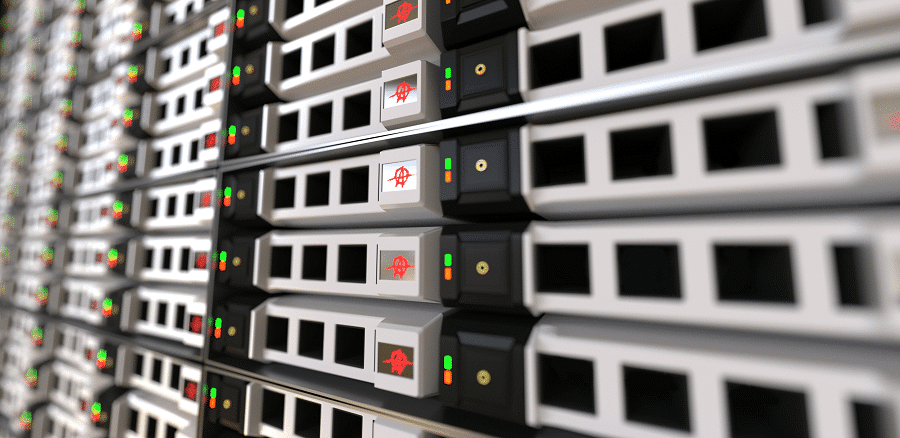Disaster backup and recovery plan – these words are the most often searched lately, after the fire incident in a data center in Strasbourg. The accident destroyed one of the French data center buildings and seriously damaged another one, causing severe troubles to the OVHcloud clients. This event made millions of business owners seriously consider creating a proper disaster backup and recovery plan.
OVH data centre fire: millions of businesses lost their data

OVH data centre fire cause is the disastrous infrastructure accident that disturbs the data center owners’ minds. In their turn, millions of business owners worldwide are concerned about their data security and a plan B and making investments that minimize the impact of a power system failure on data center operations. One can never know what will happen to his/her data storage medium tomorrow. The accident in France has proved this and reminded everyone about the importance of a long-term security roadmap. It’s always wise to have a backup for a contingency case like the one described below.
A global Europe-native cloud provider has lost yottabytes of its client’s data on March 10, 2021, when the SBG2 building, owned by OVH cloud, was destroyed in the fire. The fire has also damaged the SBG1 data center, standing nearby, while the building had suffered to such an extent that it was impossible to restart it as it had been planned.
OVH is one of the most popular cloud providers, except the big three (Google Cloud, Azure, AWS). Thus, the incident led to the collapse of websites and apps all over the world. These were temporary difficulties for those owners who had thought of a disaster and recovery plan on time. However, the digital presence of many businesses has suffered irreversible losses after the OVH data center fire. Most of them had experienced major data and financial losses, while others were paralyzed.
Server Data Recovery. Case 1
A company from Europe, which has been a client of Optimum Web for a long time, contacted us with an urgent request. The company’s servers were located in the very place of the fire. Most of them were not affected, except a single server, but it didn’t help in any way. All the network hardware was destroyed, as was the music application behind a big business.
Optimum Web was able to restore only a part of the data automatically. And that’s sole because the client made a prudent decision to backup a Terabyte of media data on time. Fortunately, our engineers were able to manually restore the rest of the information, including all the settings and application source code. However, a complete backup and disaster recovery are not always possible when you rely on bare-metal servers only. Companies could have irretrievably lost some of the data in other cases.
VOIP Application Recovery. Case 2
The disaster recovery and backup plan was the central point of the server data recovery case with another client of Optimum Web – a VOIP telephony company. The client’s employee has accidentally deleted the server, having no snapshots or backups. Our developer had to restore everything from the repository manually. Luckily the client used Git as such, so there appeared some configuration files remained accidentally secure.
Our engineers managed to recover the entire service manually. However, all the data was lost, as the backup the client had was outdated. Respectively, all the information gathered after the backup date could not be restored. The client was lucky to save his service but had to start all the work from scratch. The situation could have looked more optimistic if he had a backup and recovery plan for his database and had managed to put it in action.
Disaster backup and data recovery have come a long way from media-vault manual backup to safe, quick, and continuous backup and data recovery. There is available a wide array of efficient modern cloud-based solutions. However, there are still cases when the careful manual recovery performed by a professional is required. That was precisely what happened to our client.
Why do you need a backup and recovery strategy?

The solid backup and recovery strategy is something every farsighted business owner thinks about from the very beginning. He realizes that all computer hardware fails at a certain point, be it from age or an accident. The massive data loss, inevitable in this case, can cause severe consequences, such as sharp profits drop or even an overall business failure. This makes an adequate business continuity strategy and an efficient BDR (backup and disaster recovery) solution crucial for nearly every modern business.
The future is unpredictable; natural disasters, cyber-attacks, or hard drive malfunctions can hit unexpectedly. But there is a reliable way to stay assured your information is secure. You need to take care of timely backups and quick data recoverability. Thus you’ll be able to minimize the downtime if something happens and save your business.
What is disaster recovery (DR)?
Disaster recovery (DR) is how a company regains its IT infrastructure access and mission-critical functions after extreme events happen. A cyberattack, a natural or a human-made disaster, hardware failure, human error, or even a business failure resulting from the COVID-19 pandemic can be named as such. So if your business uses a computer, a solid disaster data backup and recovery plan is a must.
Of course, eliminating every possible cause of an IT infrastructure collapse can be expensive. However, having a disaster backup and recovery plan, considering this, is the only way to stay calm. Thus you can be assured your service won’t be interrupted and your information won’t be lost due to a hardware failure. Moreover, the older solution, implying regular data backups, is even more expensive.
Why is a backup and disaster recovery plan important?
Thinking about plan B for data, one should remember there is an essential difference between disaster recovery and backup.
Backup itself is a process of creating one or more extra copies of the information you want to protect. You can restore your data using the latest preserved copy. A proper solution in place could help in many cases, such as:
- software upgrade
- hardware damage
- database corruption or accidental deletion
- theft
- the human factor, and more.
A disaster recovery plan embraces detailed processes designed to fast IT resources and infrastructure access reestablishment. It also encompasses the complete strategy for reacting to a disaster event and putting the backups into action, while disaster doesn’t necessarily mean a major accident. The situation when your entire network falls, paralyzing the work of your employees, can be called a disaster.
Key reasons why your business needs a comprehensive disaster recovery plan
Sometimes businesses confuse backup for disaster recovery. However, simply having multiple information copies won’t keep your business running when a severe disruption happens. And even if you lose less than 100 files, which is considered a small loss, be prepared to experience downtime and revenue fall.
Nevertheless, the financial damage is just one of several reasons every business should have a proper disaster backup and recovery plan. Here are the other five:
Reason 1. A broad range of threats
Being an essential part of a business, data is a subject of many threats, like:
- natural disasters
- physical device damage
- technical threats
- human threats
A correctly done due diligence can protect you from some of them, but there is always room for danger caused by the minor vulnerability.
Reason 2. Security measures fail
There are no 100% efficient security measures; even the toughest of them can fail, letting the ransomware viruses in. The possibility of retrieving uninfected versions of your data without interacting with cybercriminals is priceless. That is usually foreseen by a good backup and disaster recovery plan.
Reason 3. Productivity losses
Most modern businesses rely on data in their everyday and strategical activity. That means the data loss will seriously damage your productivity making your employees unable to work. The longer the data recovery is delayed, the harder your profits suffer.
Reason 4. Cost savings
Random and urgent lost data recovery attempts can be an expensive measure. But if you are prepared ahead for data loss probability and have a solid plan of actions, you will spend much less money. Acting quickly, you will save the recovery processes budget and reduce the productivity-related damage.
Reason 5. Data loss
Being able to retrieve the lost data, you can protect your business from major financial and reputational damages. This ability implies creating data backups on bare-metal servers and a cloud backup service in place. Physical storage devices make your data exposed to the threats mentioned above. The cloud-based disaster backup and recovery services allow you to quickly and effectively recover your information despite the reason for their loss.
Disaster Recovery and Backup Services | Optimum Web Approach

Disaster recovery and backup services provided by Optimum Web are the most in-demand services in IT nowadays. The consistently growing need to protect their data makes businesses seek them in the first place. The decreasing expenses for cloud-based services come as a very welcomed bonus. With the disaster recovery getting easier and cheaper, more companies become better prepared without going over budget.
The Disaster Recovery as a Service benefits include:
- easier deployment
- straightforward regular testing
- lower expenditures
- increased flexibility, allowing companies to choose only the services they need.
Of course, the cloud servers can also be damaged in a disaster, such as the Strasbourg data center fire, but they have a considerable advantage. You can snapshot them, i.e., create images of the entire server that can be easily transferred to another data center without any loss. However, many people still prefer bare metal servers and usually forget about backups.
If you use cloud-based servers, then, as a rule, cloud providers offer their backup / restore solutions and various snapshot mechanisms. There are also third-party services, of which the following can be distinguished:
Open Source tools: 1. Bacula 2. Rsync 3. Conserve 4. Grive2 5. Duplicity 6. Custom written scripts Bash/Python
Cloud backup services: 1. iDrive 2. Backblaze.com 3. Crashplan.com 4. Spinbackup.com
Optimum Web delivers high-quality custom disaster recovery & backup services tailored to your business needs. The excellent customer experience with the good-better-best rapid and iterative approach are the things we are proud of. Tightly integrated and agile cross-functional teams ensure that our backup and disaster recovery expertise is available on time and meets your requirements and needs.



